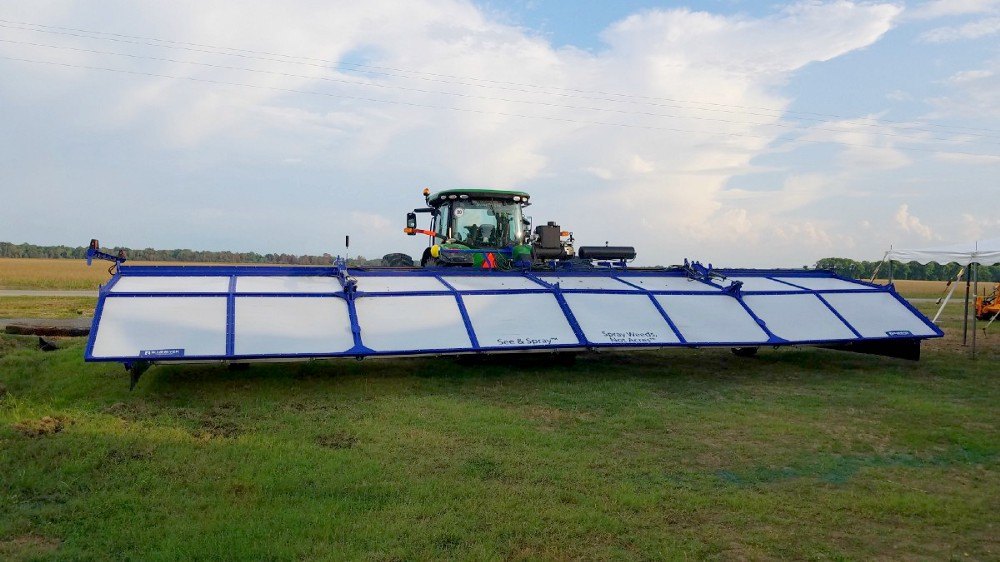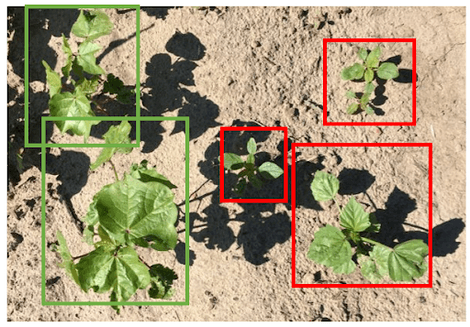John Deere Subsidiary Blue River Technology is Transforming Agriculture through Machine Learning

Blue River Technology aims to revolutionize the agricultural industry through the use of robotics and machine learning to fight weeds and improve crop yield
Blue River Technology was started by two Stanford graduate students, Jorge Heraud and Lee Redden, in 2011 with the mission to “make farming more sustainable through robotics and computer vision”.[1] The startup, which has pioneered machine learning in agricultural fields by focusing on weed control, was acquired by Fortune 500 John Deere for $305 million in 2017.[2]
Figure 1: Blue River Technology founders Lee Redden and Jorge Heraud [3]
Blue River Technology has revolutionized weed control through its main product, the “See and Spray” machine. This See and Spray machine can be attached to tractors and pulled through crop fields to distinguish between weeds and crops, which often look very similar and are indistinguishable to the untrained eye. The technology can then precisely target only the weeds so that unwanted plants are sprayed with herbicide while the crops are left untouched.
Figure 2: See and Spray machine attached to a tractor
How exactly does Blue River achieve this monumental feat? As the tractor drives through the field at 12 miles per hour, the See and Spray machine leverages computer vision via its front and rear cameras along with machine learning to determine whether plants are crops or weeds. The See and Spray machine processes images of plants at a rate of over 20 times per second. The machine then compares these images to the training library of over one million images and uses technology similar to facial recognition to identify plants as herbs or crops.[4]
In its current stage, Blue River is taking advantage of Facebook’s PyTorch open-source machine-learning framework to train the models.[5] Each frame captured by See and Spray’s cameras is analyzed using an algorithm and convolutional neural network to identify and map weeds. Once the map has been created in a few milliseconds, the robot then sprays only the locations where weeds were identified.[6] By consulting with professional agronomists and weed scientists to correctly identify and label weeds and then building a set of internal libraries on top of PyTorch Blue River can perform repeatable machine learning experiments while still benefitting from the speed and flexibility of PyTorch.[7]
Figure 3: See and Spray differentiates crops (in green) from weeds (in red) [8]
Since farmers manage huge fields with millions of plants, the See and Spray robotic technology enables farmers to reduce their herbicide costs by applying herbicide only to unwanted plants rather than to the entire field. In fact, Blue River’s initial goal is to reduce usage by 80-90% through its more targeted application, translating to thousands of dollars in savings that will go straight to the farmer’s bottom line.[9] Added to that, the efficient and consistent application of herbicide helps to prevent herbicide resistance.[10] Since there are an estimated 250 species of herbicide resistant weeds, with uncontrolled weeds resulting in annual losses of approximately $43 billion in corn and soybean crops, Blue River’s technology will enable higher yield crops and profits.[11]
From a data analytics perspective, the See and Spray machine also allows farmers to know exactly how many herbs are in the fields as well as the types of herbs and their location. Beginning in June of this year, Blue River will start to capture value by selling See and Spray machines installed on John Deere Sprayer machines. This will enable the farmers to tailor their herbicide treatment program and John Deere estimates reduced herbicide usage of 77%.[12]
Figure 4: See and Spray machine in the field
Overall, Blue River’s technology has the capacity to bring AI and ML to global farming practices, an industry that is fundamental to our livelihoods and economy. With agriculture as the basis of our food supply and current high levels of crop spoilage, Blue River is exploiting a huge opportunity. Blue River is uniquely positioned with John Deere as a parent, giving the subsidiary access to John Deere equipment to continue to test and expand and credibility and global reach through John Deere’s network of customers.
However, as a result of the fragmented nature of global farm operations, widespread scaling will still be difficult. The investments in robotics and machine learning implementation and maintenance is extremely expensive. And while there will be payoffs in the long run, many smaller farmers do not have the resources or desire to make these upfront investments and will prefer to farm using traditional methods. Some changes that the company could make to alleviate these adoption issues would be to offer a subscription-based model which could reduce upfront costs and still enable the farmers to benefit from the savings and improved sustainability that See and Spray offers. Alternatively, Blue River Technology could develop miniature versions of the technology for use on small scale farms.
Despite these challenges, there are innumerable opportunities for Blue River to expand its products and services. In fact, the global AI in Agriculture market is forecast to reach $2.4 billion by 2026 with a compound annual growth rate of 20% from 2019 to 2026.[13] And while the See and Spray machine is still in field testing stage Blue River Technology is perfectly positioned to capitalize on the increased investment of AI and ML in agriculture to control pests and produce food more efficiently. The company is already planning to expand to other agricultural processes such as application of insecticides, fungicides and fertilizers.[14] Furthermore as farm labor becomes more scarce and expensive, the value proposition of Blue River will become even more appealing as a method to reduce materials and labor costs and to become more efficient with production. And with the backing of agricultural giant John Deere, Blue River can expand its product line to other tractor robots or drones that can further increase productivity and efficiency.
Endnotes
[1] https://www.fastcompany.com/company/blue-river-technology
[2] https://www.wired.com/story/why-john-deere-just-spent-dollar305-million-on-a-lettuce-farming-robot/
[3] https://www.kazu.org/post/smart-machine-leading-way-future-agriculture#stream/0
[5] https://ai.facebook.com/blog/pytorch-drives-next-gen-intelligent-farming-machines/
[6] https://medium.com/pytorch/ai-for-ag-production-machine-learning-for-agriculture-e8cfdb9849a1
[7] https://www.zdnet.com/article/python-powered-machine-learning-tool-drives-robot-farming-project/
[8] https://ai.facebook.com/blog/pytorch-drives-next-gen-intelligent-farming-machines/
[10] https://www.analyticsinsight.net/top-10-ai-and-robotics-companies-transforming-agriculture-sector/
[11] https://emerj.com/ai-sector-overviews/ai-agriculture-present-applications-impact/







Great blog post Tiffany! I loved learning about Blue River technology and feel that this could be a game changer for agriculture. I can also see the added benefit of reduced chemicals on edible portions of crop. Do you have any insights if the company is planning to expand to other countries – more specifically developing countries? It will be very useful for farmers who do not struggle with high cost of fertilizers.
Super interesting Tiffany! Curious to know how John Deere integrated this startup into their big corporate structure post acquisition. Did they leave it as a stand alone unit?